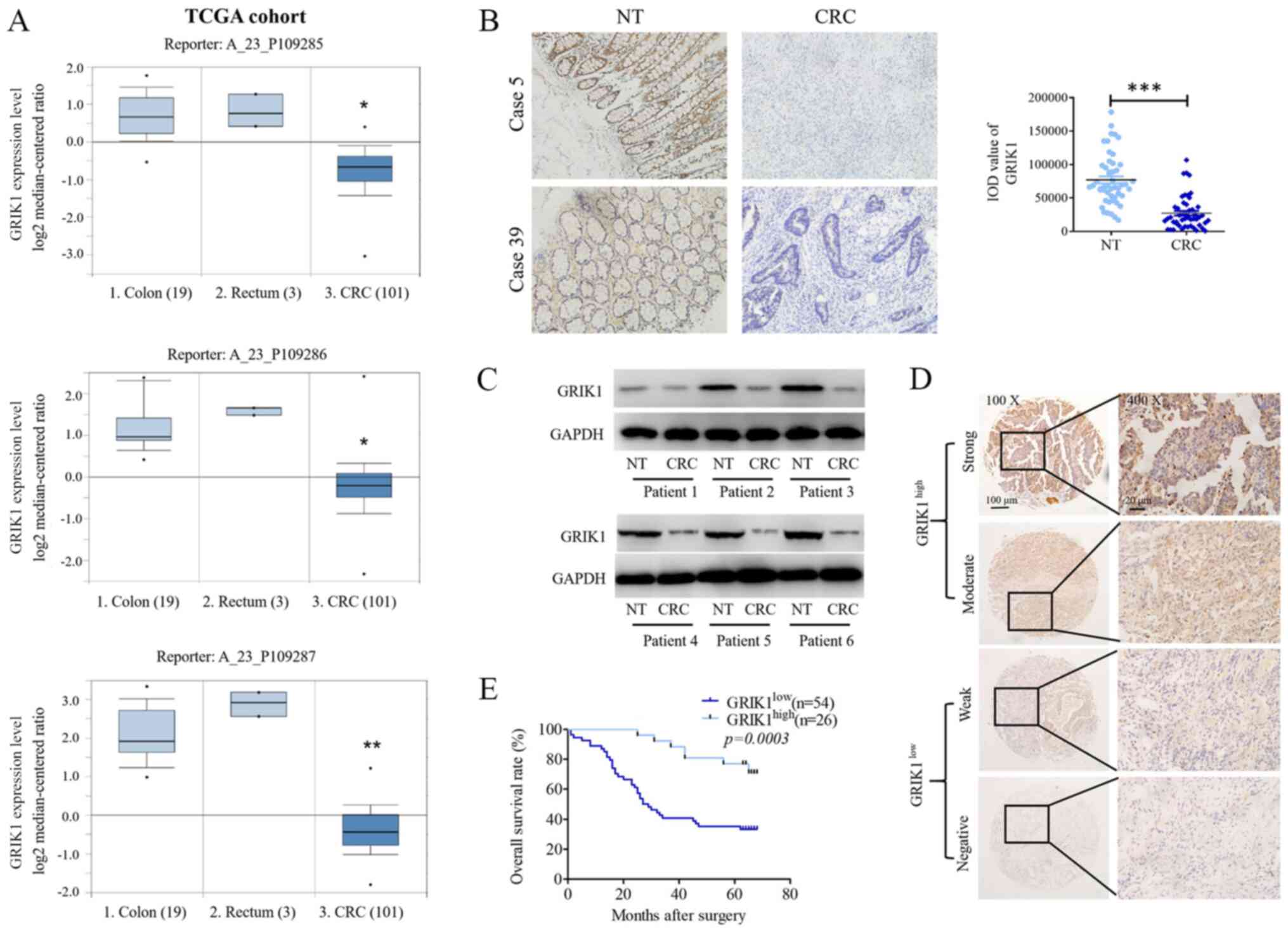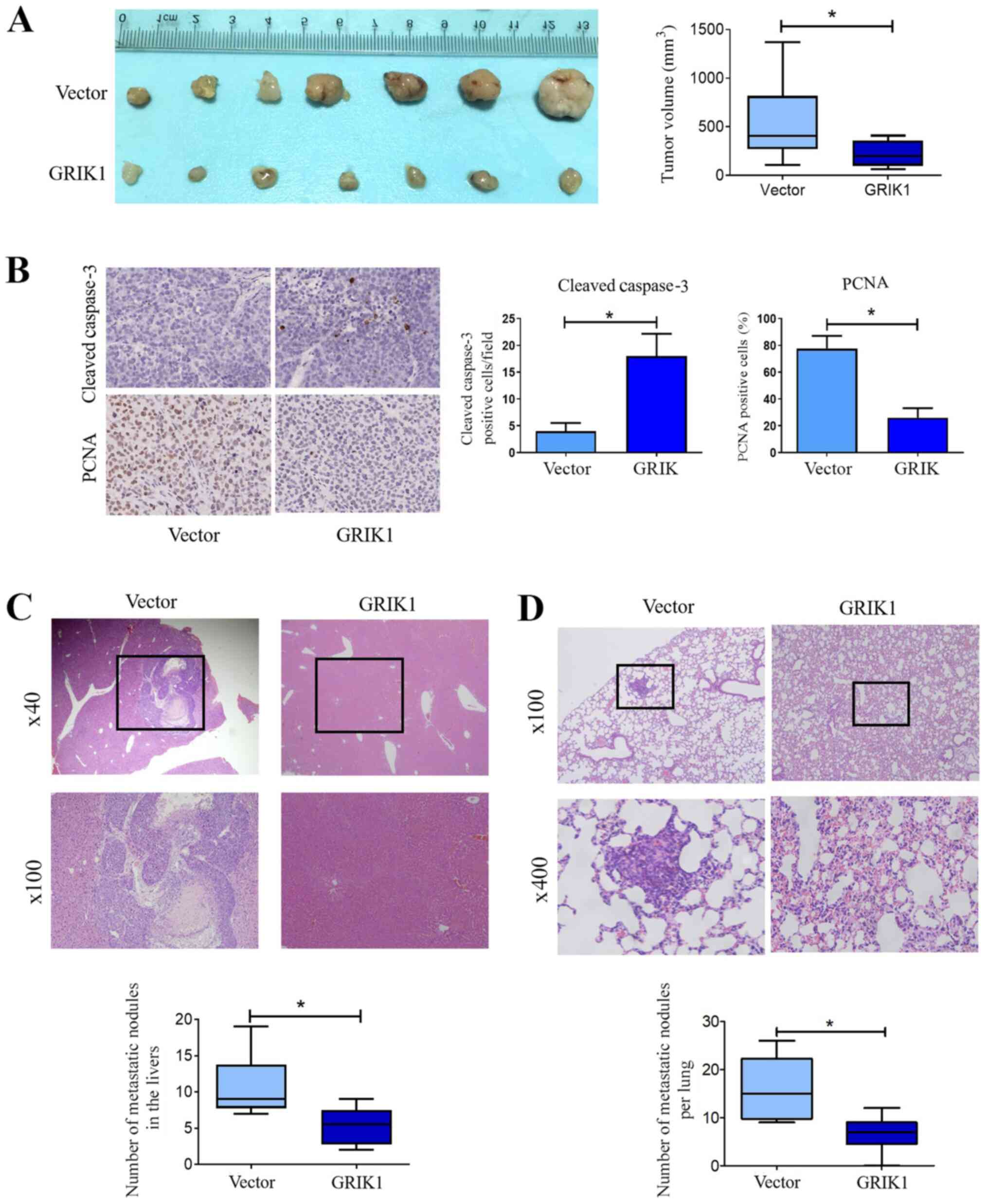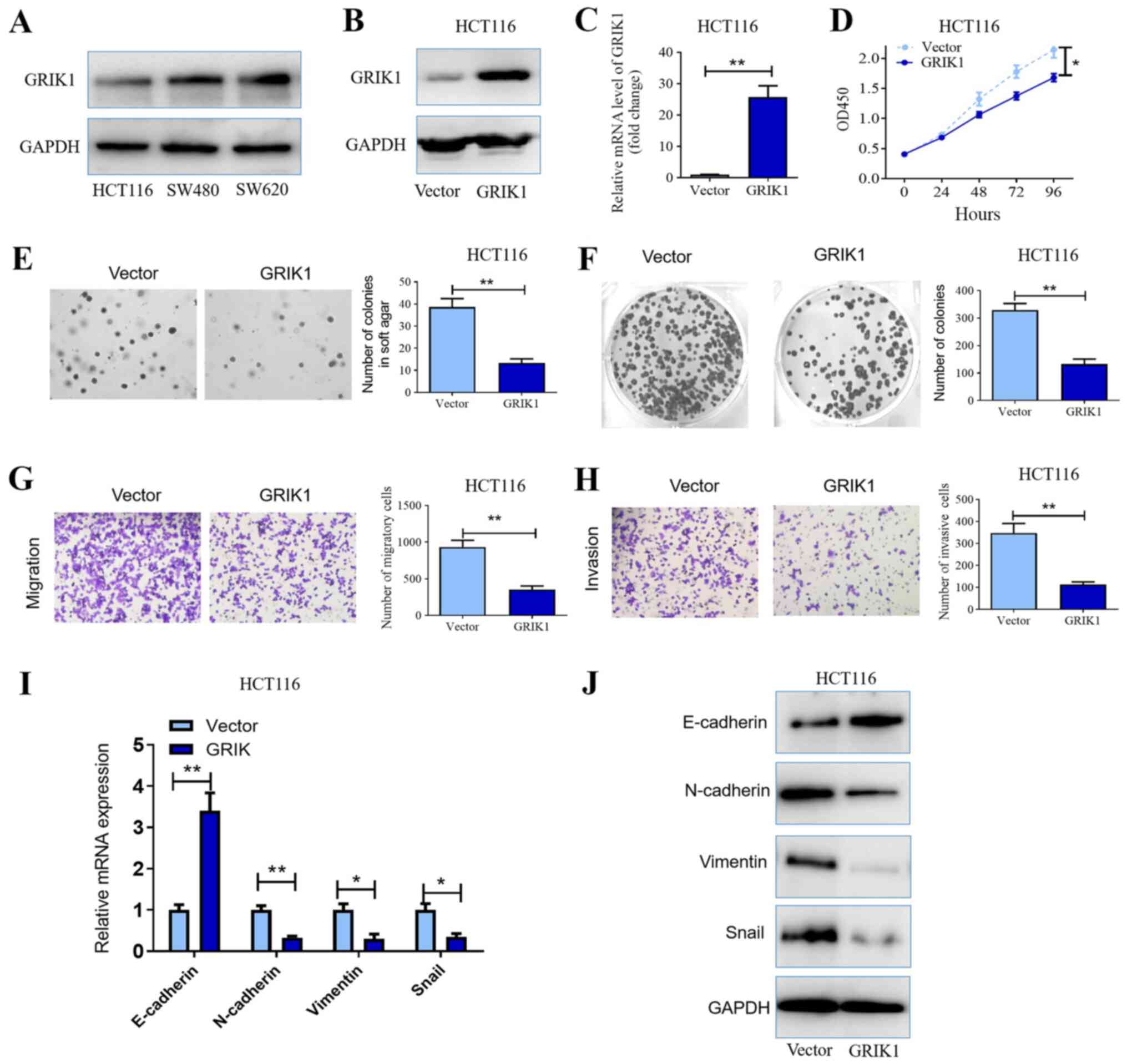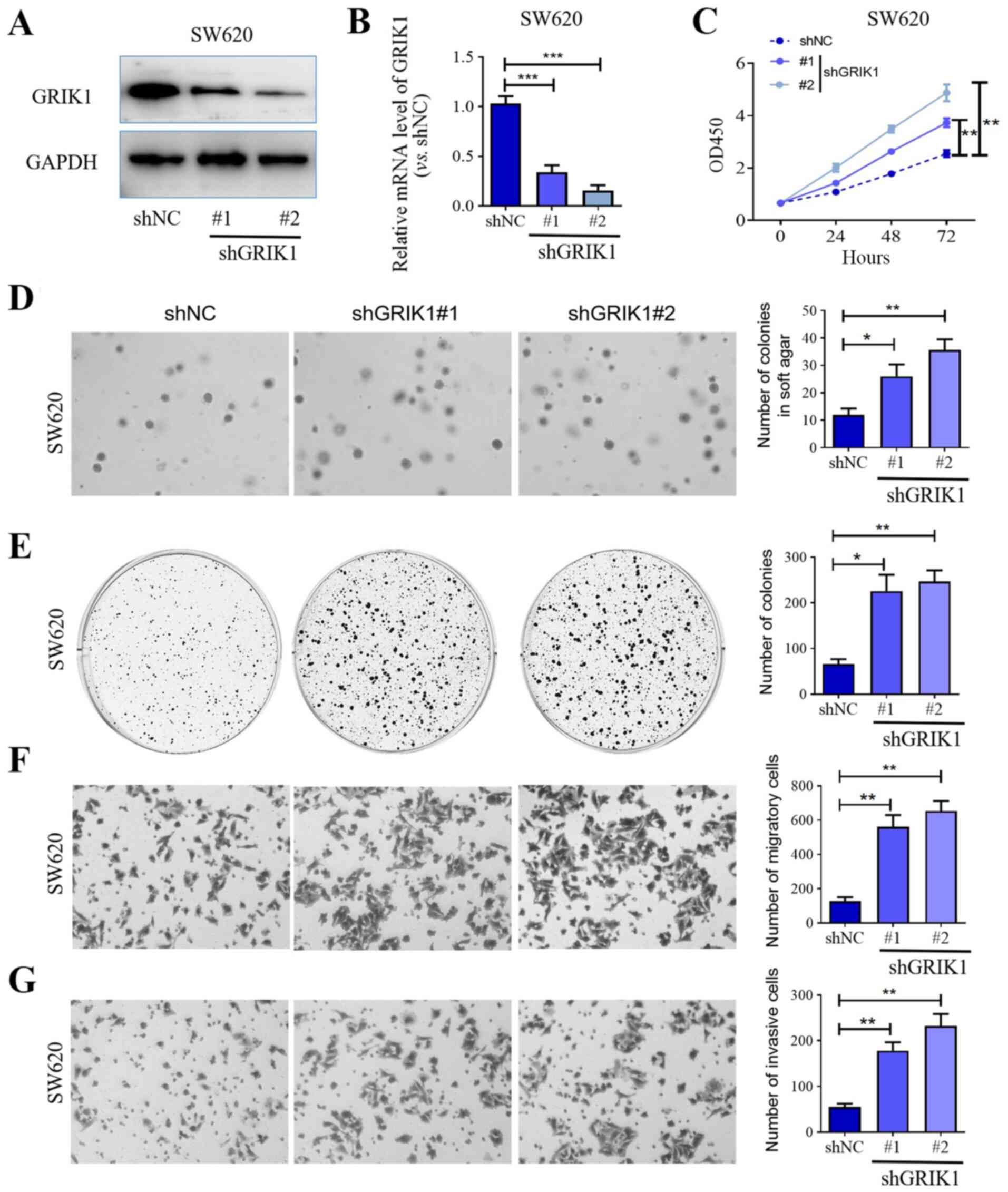|
1
|
Rawla P, Sunkara T and Barsouk A:
Epidemiology of colorectal cancer: Incidence, mortality, survival,
and risk factors. Prz Gastroenterol. 14:89–103. 2019.PubMed/NCBI View Article : Google Scholar
|
|
2
|
Winawer S, Fletcher R, Rex D, Bond J, Burt
R, Ferrucci J, Ganiats T, Levin T, Woolf S, Johnson D, et al:
Gastrointestinal Consortium Panel: Colorectal cancer screening and
surveillance: Clinical guidelines and rationale-Update based on new
evidence. Gastroenterology. 124:544–560. 2003.PubMed/NCBI View Article : Google Scholar
|
|
3
|
Rees M, Tekkis PP, Welsh FK, O'Rourke T
and John TG: Evaluation of long-term survival after hepatic
resection for metastatic colorectal cancer: A multifactorial model
of 929 patients. Ann Surg. 247:125–135. 2008.PubMed/NCBI View Article : Google Scholar
|
|
4
|
Wei Y, Zhang X, Wang G, Zhou Y, Luo M,
Wang S and Hong C: The impacts of pretreatment circulating
eosinophils and basophils on prognosis of stage Ⅰ-Ⅲ colorectal
cancer. Asia Pac J Clin Oncol. 14:e243–e251. 2018.PubMed/NCBI View Article : Google Scholar
|
|
5
|
Shi W, Ye Z, Zhuang L, Li Y, Shuai W, Zuo
Z, Mao X, Liu R, Wu J, Chen S, et al: Olfactomedin 1 negatively
regulates NF-κB signalling and suppresses the growth and metastasis
of colorectal cancer cells. J Pathol. 240:352–365. 2016.PubMed/NCBI View Article : Google Scholar
|
|
6
|
Qiu YY, Hu Q, Tang QF, Feng W, Hu SJ,
Liang B, Peng W and Yin PH: MicroRNA-497 and bufalin act
synergistically to inhibit colorectal cancer metastasis. Tumour
Biol. 35:2599–2606. 2014.PubMed/NCBI View Article : Google Scholar
|
|
7
|
Yang Y, Weng W, Peng J, Hong L, Yang L,
Toiyama Y, Gao R, Liu M, Yin M, Pan C, et al: Fusobacterium
nucleatum increases proliferation of colorectal cancer cells
and tumor development in mice by activating toll-like receptor 4
signaling to nuclear factor-κB, and up-regulating expression of
microRNA-21. Gastroenterology. 152:851–866.e24. 2017.PubMed/NCBI View Article : Google Scholar
|
|
8
|
Carethers JM and Jung BH: Genetics and
genetic biomarkers in sporadic colorectal cancer. Gastroenterology.
149:1177–1190.e3. 2015.PubMed/NCBI View Article : Google Scholar
|
|
9
|
Okugawa Y, Grady WM and Goel A: Epigenetic
alterations in colorectal cancer: Emerging biomarkers.
Gastroenterology. 149:1204–1225.e12. 2015.PubMed/NCBI View Article : Google Scholar
|
|
10
|
Prahallad A, Sun C, Huang S, Di
Nicolantonio F, Salazar R, Zecchin D, Beijersbergen RL, Bardelli A
and Bernards R: Unresponsiveness of colon cancer to BRAF(V600E)
inhibition through feedback activation of EGFR. Nature.
483:100–103. 2012.PubMed/NCBI View Article : Google Scholar
|
|
11
|
Barras D, Missiaglia E, Wirapati P, Sieber
OM, Jorissen RN, Love C, Molloy PL, Jones IT, McLaughlin S, Gibbs
P, et al: BRAF V600E mutant colorectal cancer subtypes based on
gene expression. Clin Cancer Res. 23:104–115. 2017.PubMed/NCBI View Article : Google Scholar
|
|
12
|
Arriba M, García JL, Inglada-Pérez L,
Rueda D, Osorio I, Rodríguez Y, Álvaro E, Sánchez R, Fernández T,
Pérez J, et al: DNA copy number profiling reveals different
patterns of chromosomal instability within colorectal cancer
according to the age of onset. Mol Carcinog. 55:705–716.
2016.PubMed/NCBI View
Article : Google Scholar
|
|
13
|
Koi M, Garcia M, Choi C, Kim HR, Koike J,
Hemmi H, Nagasaka T, Okugawa Y, Toiyama Y, Kitajima T, et al:
Microsatellite alterations with allelic loss at 9p24.2 signify
less-aggressive colorectal cancer metastasis. Gastroenterology.
150:944–955. 2016.PubMed/NCBI View Article : Google Scholar
|
|
14
|
Voorneveld PW, Kodach LL, Jacobs RJ, Liv
N, Zonnevylle AC, Hoogenboom JP, Biemond I, Verspaget HW, Hommes
DW, de Rooij K, et al: Loss of SMAD4 alters BMP signaling to
promote colorectal cancer cell metastasis via activation of Rho and
ROCK. Gastroenterology. 147:196–208.e13. 2014.PubMed/NCBI View Article : Google Scholar
|
|
15
|
Dow LE, O'Rourke KP, Simon J,
Tschaharganeh DF, van Es JH, Clevers H and Lowe SW: Apc restoration
promotes cellular differentiation and reestablishes crypt
homeostasis in colorectal cancer. Cell. 161:1539–1552.
2015.PubMed/NCBI View Article : Google Scholar
|
|
16
|
Li X, Chen T, Shi Q, Li J, Cai S, Zhou P,
Zhong Y and Yao L: Angiopoietin-like 4 enhances metastasis and
inhibits apoptosis via inducing bone morphogenetic protein 7 in
colorectal cancer cells. Biochem Biophys Res Commun. 467:128–134.
2015.PubMed/NCBI View Article : Google Scholar
|
|
17
|
Yang C, Wang S, Ruan H, Li B, Cheng Z, He
J, Zuo Q, Yu C, Wang H, Lv Y, et al: Downregulation of PDK4
increases lipogenesis and associates with poor prognosis in
hepatocellular carcinoma. J Cancer. 10:918–926. 2019.PubMed/NCBI View Article : Google Scholar
|
|
18
|
Livak KJ and Schmittgen TD: Analysis of
relative gene expression data using real-time quantitative PCR and
the 2(-Δ Δ C(T)) method. Methods. 25:402–408. 2001.PubMed/NCBI View Article : Google Scholar
|
|
19
|
Hasle H, Clemmensen IH and Mikkelsen M:
Risks of leukaemia and solid tumours in individuals with Down
syndrome. Lancet. 355:165–169. 2000.PubMed/NCBI View Article : Google Scholar
|
|
20
|
Hasle H, Friedman JM, Olsen JH and
Rasmussen SA: Low risk of solid tumors in persons with Down
syndrome. Genet Med. 18:1151–1157. 2016.PubMed/NCBI View Article : Google Scholar
|
|
21
|
Pussegoda KA: Down syndrome patients are
less likely to develop cancer. Clin Genet. 78:35–37.
2010.PubMed/NCBI View Article : Google Scholar
|
|
22
|
Jin H, Wang C, Jin G, Ruan H, Gu D, Wei L,
Wang H, Wang N, Arunachalam E, Zhang Y, et al: Regulator of
calcineurin 1 gene isoform 4, down-regulated in hepatocellular
carcinoma, prevents proliferation, migration, and invasive activity
of cancer cells and metastasis of orthotopic tumors by inhibiting
nuclear translocation of NFAT1. Gastroenterology. 153:799–811.e33.
2017.PubMed/NCBI View Article : Google Scholar
|
|
23
|
Dey N, Krie A, Klein J, Williams K,
McMillan A, Elsey R, Sun Y, Williams C, De P and Leyland-Jones B:
Down syndrome and triple negative breast cancer: A rare occurrence
of distinctive clinical relationship. Int J Mol Sci.
18(E1218)2017.PubMed/NCBI View Article : Google Scholar
|
|
24
|
Kuwahara K, Yamamoto-Ibusuki M, Zhang Z,
Phimsen S, Gondo N, Yamashita H, Takeo T, Nakagata N, Yamashita D,
Fukushima Y, et al: GANP protein encoded on human chromosome
21/mouse chromosome 10 is associated with resistance to mammary
tumor development. Cancer Sci. 107:469–477. 2016.PubMed/NCBI View Article : Google Scholar
|
|
25
|
Hattori M, Fujiyama A, Taylor TD, Watanabe
H, Yada T, Park HS, Toyoda A, Ishii K, Totoki Y, Choi DK, et al:
Chromosome 21 mapping and sequencing consortium: The DNA sequence
of human chromosome 21. Nature. 405:311–319. 2000.PubMed/NCBI View
Article : Google Scholar
|
|
26
|
Li W, Wang X and Li S: Investigation of
copy number variations on chromosome 21 detected by comparative
genomic hybridization (CGH) microarray in patients with congenital
anomalies. Mol Cytogenet. 11(42)2018.PubMed/NCBI View Article : Google Scholar
|
|
27
|
Barbon A and Barlati S: Genomic
organization, proposed alternative splicing mechanisms, and RNA
editing structure of GRIK1. Cytogenet Cell Genet. 88:236–239.
2000.PubMed/NCBI View Article : Google Scholar
|
|
28
|
Sander T, Hildmann T, Kretz R, Fürst R,
Sailer U, Bauer G, Schmitz B, Beck-Mannagetta G, Wienker TF and
Janz D: Allelic association of juvenile absence epilepsy with a
GluR5 kainate receptor gene (GRIK1) polymorphism. Am J Med Genet.
74:416–421. 1997.PubMed/NCBI
|
|
29
|
Matsuda K: Novel susceptibility loci for
hepatocellular carcinoma in chronic HBV carriers. Hepatobiliary
Surg Nutr. 1:59–60. 2012.PubMed/NCBI View Article : Google Scholar
|
|
30
|
Luo Y, Xie C, Brocker CN, Fan J, Wu X,
Feng L, Wang Q, Zhao J, Lu D, Tandon M, et al: Intestinal PPARα
protects against colon carcinogenesis via regulation of
methyltransferases DNMT1 and PRMT6. Gastroenterology.
157:744–759.e4. 2019.PubMed/NCBI View Article : Google Scholar
|
|
31
|
Minbay Z, Serter Kocoglu S, Gok Yurtseven
D and Eyigor O: Immunohistochemical localization of ionotropic
glutamate receptors in the rat red nucleus. Bosn J Basic Med Sci.
17:29–37. 2017.PubMed/NCBI View Article : Google Scholar
|
|
32
|
Kuo TC, Chen CK, Hua KT, Yu P, Lee WJ,
Chen MW, Jeng YM, Chien MH, Kuo KT, Hsiao M, et al: Glutaminase 2
stabilizes Dicer to repress Snail and metastasis in hepatocellular
carcinoma cells. Cancer Lett. 383:282–294. 2016.PubMed/NCBI View Article : Google Scholar
|
|
33
|
Cacace A, Sboarina M, Vazeille T and
Sonveaux P: Glutamine activates STAT3 to control cancer cell
proliferation independently of glutamine metabolism. Oncogene.
36:2074–2084. 2017.PubMed/NCBI View Article : Google Scholar
|
|
34
|
Christa L, Simon MT, Flinois JP, Gebhardt
R, Brechot C and Lasserre C: Overexpression of glutamine synthetase
in human primary liver cancer. Gastroenterology. 106:1312–1320.
1994.PubMed/NCBI View Article : Google Scholar
|


















